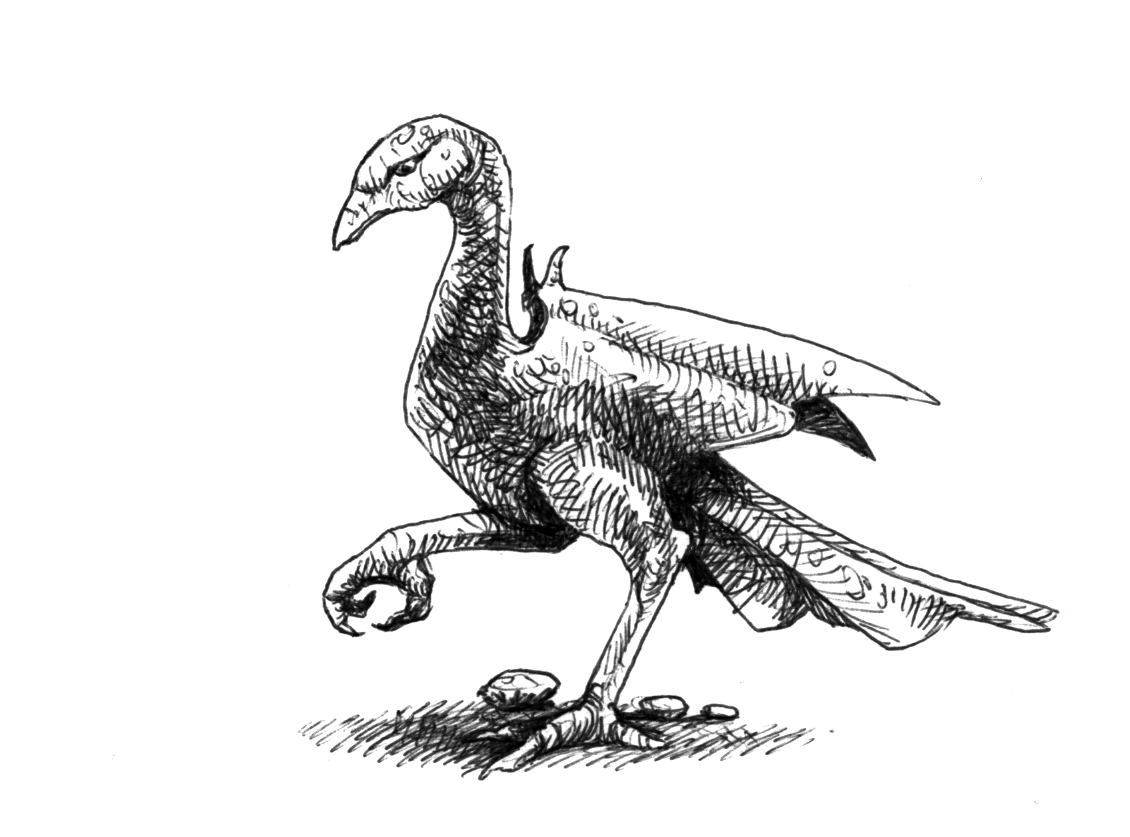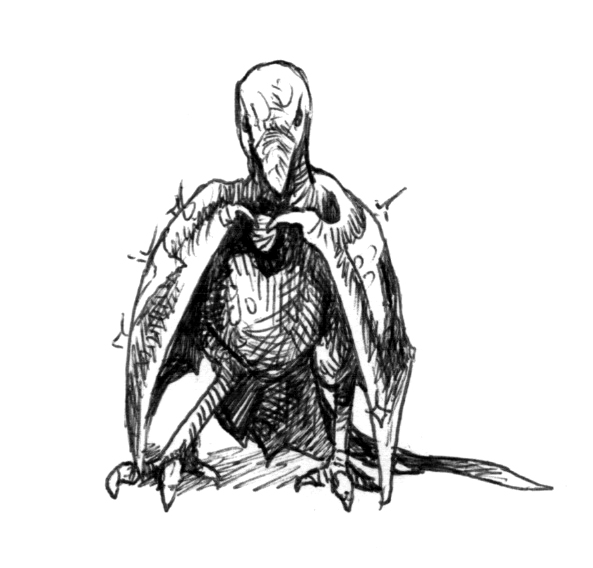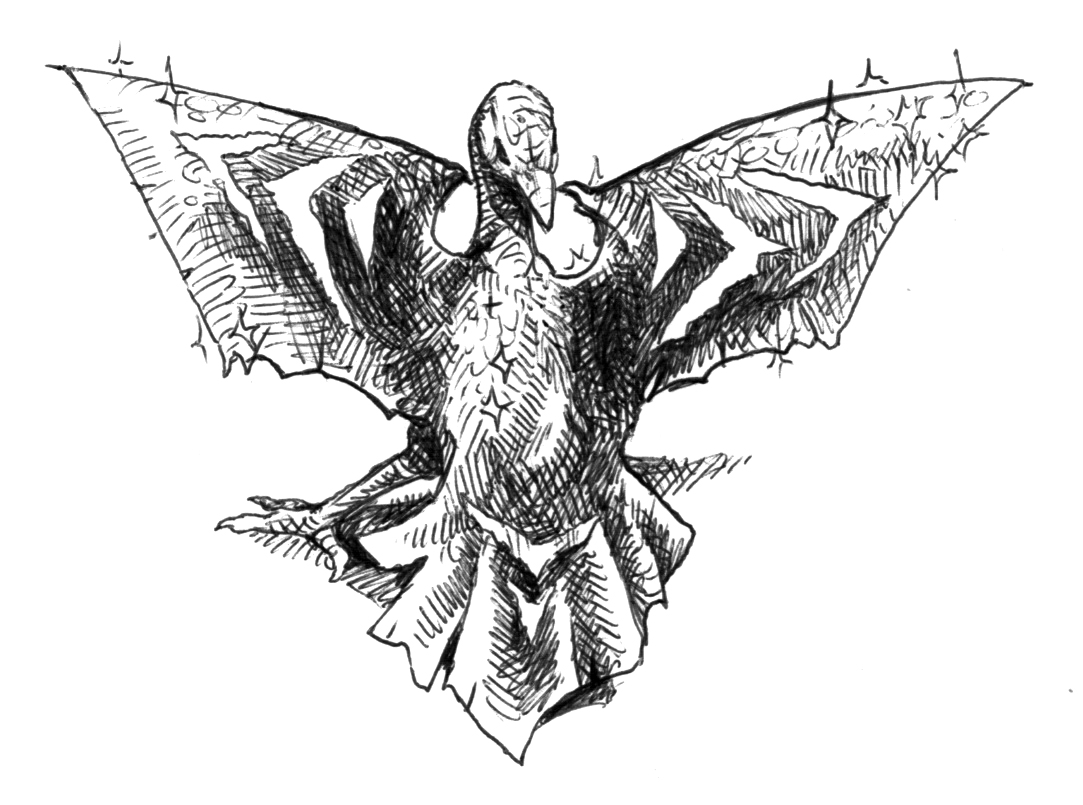Sargmay
This article originally appeared in the March/April 2018 issue, with only the first illustration.
| ANIMAL | HITS | SPEED |
|---|---|---|
| Sargmay | 5 | 10m |
| SKILLS | Recon 1, Survival 0 | |
| ATTACKS | Beak (1D) [Attack 12+, Flee 9-] | |
| TRAITS | Fast Metabolism (+1), Small (-2), Glider | |
| BEHAVIOUR | Herbivore, Intermittent | |
| Morphology | Bilateral symmetry, tetrapod (four-limbed), biped (two hind limbs used for locomotion), winged (two winged forelimbs with grasping palp) |
|---|---|
| Biochemistry | C/H/O/N, Broadly compatible with human |
| Respiration | Oxygen-nitrogen inhalant, Carbon dioxide exhalant |
| Ecology | Diurnal (active during the day) |
| Habitat | Forested areas, underbrush |
| Diet and Trophics | Herbivore/intermittent, homeothermic (keeping a constant body temperature) |
| Reproduction | Two genders, moderate sexual dimorphism, conjugal intercourse, oviparous birth (laying a clutch of five to seven leathery gray eggs), iteroparous (reproducing more than once in a lifetime). Progeny are cared for by the mother for about half a standard year. |
| Lifecycle and ontogeny | One year to sexual maturity. Lifespan about 3 years in the wild, about 10 years in captivity. |

The etymology of the word “sargmay” is somewhat obscure; it has been argued that it derives from the Bilanidin sargu (“upper garment, robe”) and maii (“red”), meaning “redcoat”. Other sources suggest that “sargmay” is a contraction of “sergeant major” in a Solomani dialect, and that the creature was named after the chevron-shaped marks on its wings that are reminiscent of sergeant’s stripes. In the Sword Worlds, the creature is known as a rooihaan or brandhaan.
Like the terrestrial pheasant, the sargmay was prized by hunters, both for its skill at evasion and for being a colourful trophy. Introducing the creature to other ecosystems proved relatively easy, so nobles and wealthy citizens exported them to many different worlds throughout the sector to stock their hunting grounds. There are now many different wild breeds of sargmay that differ mainly in size, colour and the pattern of their wings.
Recently, breeding competitions and shows have sprung up on many worlds independent of the hunting angle, where sargmay are bred mainly for colour and variety, and a very active community of breeders has formed around those events. On the occasion where prize sargmay are bought, the buyers are usually nobles or well-to-do wishing to populate their gardens with the pretty animals.
Sargmay are winged lizard-like creatures, about fifty centimeters tall when standing level. Their head terminates in a large beak-like mouth. The teeth are tiny and vestigial; the creature’s preferred diet—roots and nuts—are cracked with the hard edges of the beak. The body is covered with tiny scales; in the original strain, those are a mottled dull red, russet or ruddy brown in colour.
The well-muscled hind legs are used for running and digging for food. The claws are three-fingered, with one finger reversed (pointing backwards). The front limbs have membranes that are stretched taut when the limbs are extended. It is those membranes that give the creature its appeal as a trophy, as they are covered with shiny fibrils, like a butterfly’s wings, that serve the same way as feathers and make a paper-like rustling sound when the creature glides. Brightly scintillating, jewel-like red with the characteristic “sergeant’s stripes”, the sudden display of the wings of a male is a splendid sight. Females are less gaudy, but still sport patterns that are considered very aesthetic by the majority of sophonts. Although the sargmay’s ancestors were probably capable of flight, today’s sargmay can only glide for a few paces before having to land.
The colourful wings serve a double purpose; they are employed in the mating dance to impress the female, but more importantly, they are a means to startle and distract a predator when the sargmay is fleeing. A running sargmay is very nimble and able to abruptly change its direction, but when gliding, the creature travels in a straight line and is vulnerable to attack. The sudden snapping open of the wings at the start of the glide is accompanied by a sharp crack and presents a pattern similar to the face of a very large creature, intended to startle/frighten a pursuer for the few moments that the sargmay needs to land again.
 A single palp (finger) juts out from the upper edge of each wing;
sargmay are very dexterous in picking up objects with their palps and
holding them while gnawing on them with their beaks. The beaks are
strong enough to crack nuts, but sargmay are primarily flight animals
and only the most ill-tempered will actually bite even if threatened.
Easily domesticated and gentle towards humans, they are good companions
for children and would make perfect pets if it was possible to
house-train them.
A single palp (finger) juts out from the upper edge of each wing;
sargmay are very dexterous in picking up objects with their palps and
holding them while gnawing on them with their beaks. The beaks are
strong enough to crack nuts, but sargmay are primarily flight animals
and only the most ill-tempered will actually bite even if threatened.
Easily domesticated and gentle towards humans, they are good companions
for children and would make perfect pets if it was possible to
house-train them.
The eggs and young are incubated and raised by the mother, while the male keeps watch and provides food. If a mother and her young are threatened, the male will try to draw the predator’s attention and lure it away from the nest, occasionally flashing a bit of colour to keep its pursuer interested. Birth rates are two or three males to every female, but attrition by predation in the wild means that fewer males survive and the numbers balance out. In captivity, the greater number of males makes for some problems, as the competition for mates is often resolved in aggressive fights that can damage the pretty wings. Currently, most sargmay keepers try to breed for less aggression. On less civilised planets and in certain ghettos, though, sargmay fights are a popular form of entertainment, and there are a few breeds of “fighting ’mays” with increased aggressive potential.
A killed sargmay will yield about two kilograms of meat, which is considered a delicacy in some places. It spoils quickly, however, and cannot be preserved without compromising the taste. The meat of captive sargmay is somewhat drier and lacks the rich flavour of wild specimens. Connoisseurs invariably demand freshly hunted animals.
Adventure Seeds
- The travellers are heading back to the ship from an expedition in the forest. Their ATV startles a group of sargmay. One moment, they are are surrounded by running animals, then suddenly—CRACK!—they all take flight and snap their wings open right in front of the windshield. It takes a very difficult driving check to avoid swerving in shock and hitting the underbrush.
- The annual festival in the city sees thousands of live sargmay released in a dazzling orgy of colour. The travellers, along with many other teams of helpers, are hired to catch and cage several loads of them for the ritual. However, several environmentalist groups picket their ship and try to hinder them at every turn, claiming animal abuse and pressuring for abolishment of the festival. Many of the citizens are sympathetic, but the festivities draw thousands of tourists that provide a good deal of the planet’s income, so the authorities are turning a deaf ear.
- A breeder hires the travellers to protect him and his prize sargmay—he is heading to a convention where he can rightfully expect to make first place in the “most colours” category, and he expects a certain rival to try and steal or poison his animal. It turns out the rival has hired a team of spacers just as tough and resourceful as the travellers. The conflict will run behind the scenes, and everyone needs to put on a nice face in public or risk being expelled from the grounds.
- Abroad in the sleazier parts of the starport, the travellers meet their patron at a ’may fight. The gamblers are very excited, and large bets are being made. Everyone’s attention is riveted on the fighting sargmay in the pit, making it easy to do some discreet business in the back row. Just as the deal gets down to brass tacks, someone accuses the pit’s proprietor of rigging the bets. The ensuing brawl turns nasty as weapons are drawn, and the travellers’ employer catches a stray bullet. If they still want the deal, they must avoid the police rushing to the scene, get him to safety and arrange medical treatment at an unregistered clinic (public hospitals ask too many questions).
- A noble contacts the travellers. He has spent large sums of money to have his hunting preserve stocked with a certain very expensive and beautiful breed of sargmay. However, it lies next to a large sargmay farm, and the farmers have had trouble with the surplus males fighting among themselves. Their answer was to release part of the male population into the wild, where they are now mating uncontrollably with the noble’s game and producing non-purebred offspring. The noble is furious and wants to hire the travellers to do something about the situation.
- One of the passengers travelling on board the travellers’ ship has a sargmay pet sharing his stateroom. Unfortunately, the animal starts shedding its fibrils as a nervous reaction to space travel. The room looks like a can of red glitter exploded. First the dustbot gets clogged, and then some of the fibrils are sucked into the life support system, creating a maintenance nightmare. The passenger is a six-foot-eight barrel-chested Sword Worlder and very fond of his pet; he will fly into a rage if anyone criticises or bullies the poor little thing.
- A group of noble gourmands is visiting the planet, and the travellers are hired to go out into the wilderness and catch or shoot wild sargmay for the restaurant the nobles are expected to be visiting. An eco-terrorist group decides to turn the tables, and stalks the hunting party with sniper rifles.
- A traveller’s wallet is stolen while they are on a maglev train. The culprit flees from wagon to wagon. If they follow, they are able to corner xir—in a freight wagon full of scared sargmay snapping their wings, running around and tripping people. Not to mention the floor is slippery with a thick coating of nervous sargmay excrement.
- The compound the travellers are breaking into should be an easy target: they got a computer key that will completely disable the security system. Everything goes as planned, until they have to cross the landscaped garden. Unbeknownst to their employer, the garden was recently stocked with decorative sargmay to enliven the scenery. The males start making a terrible racket as the travellers come too close to the females and the nests.
-
 A prestigious Marine regiment proudly bears a sargmay displayed
as its badge. The regimental staff, by tradition, keep a tame
sargmay as a mascot, which is displayed on its own perch at parades.
At an important function, the regiment is supposed to render
military honours to a high-ranking noble. Unfortunately, the
Marines’ mascot falls ill. The regimental quartermaster sergeant
contacts the travellers and asks them to get a replacement sargmay
of the correct breed (!) from the neighbouring planet at all costs.
Time is very short – the function is in four weeks – so the travellers will have to get the sargmay quickly (the merchants smell
their urgency and will try to gouge them for every credit they can
get), then they need to train the creature while in jump to stay on
its display perch.
A prestigious Marine regiment proudly bears a sargmay displayed
as its badge. The regimental staff, by tradition, keep a tame
sargmay as a mascot, which is displayed on its own perch at parades.
At an important function, the regiment is supposed to render
military honours to a high-ranking noble. Unfortunately, the
Marines’ mascot falls ill. The regimental quartermaster sergeant
contacts the travellers and asks them to get a replacement sargmay
of the correct breed (!) from the neighbouring planet at all costs.
Time is very short – the function is in four weeks – so the travellers will have to get the sargmay quickly (the merchants smell
their urgency and will try to gouge them for every credit they can
get), then they need to train the creature while in jump to stay on
its display perch.
 Freelance
Traveller
Freelance
Traveller